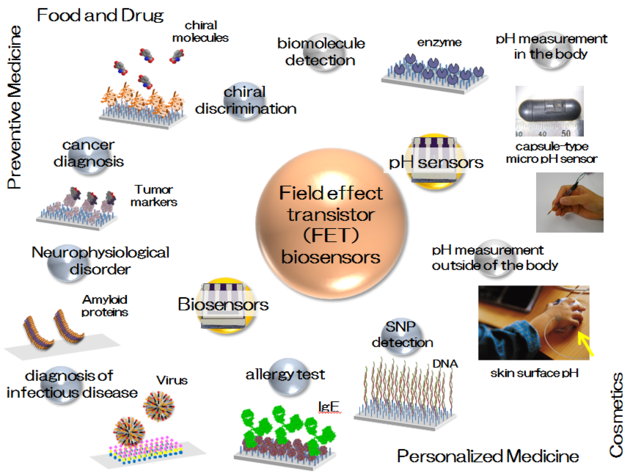Biosensors
Edited by Irfan Khan, SarMal, Jen Moreau, Sharingknowledge
What are Biosensors?
A biosensor is a diagnostic device used to investigate the concentration and presence of a specific substance in a biological sample. A biosensor integrates an active biological element (bio-receptor) with a suitable physicochemical transducer to generate an electronic signal, proportional to the concentration of a specific substance, which is then delivered to a detector. Bio-receptors are biological materials such as tissues, cell receptors, antibodies, microorganisms, enzymes, nucleic acids, and organelles. Transducers in a biosensor work on the basis of optical, electrochemical and piezoelectric principles.
There are 5 basic components of a biosensor listed below:
- Bio-receptor
- Electrical Interface/Transducer
- Signal Amplifier/Signal Detector
- Signal Processor
- Electronic Display
Initially, bio-receptor bind with the external biological substances. Bio-receptors send a response to the transducer element which generates an electrical or digital signal. The electrical signals are detected and amplified by a signal amplifier which sends the amplified signals to signal the processor. Signals are finally converted into an electrical display after going through processing steps. The working principle of a typical biosensor is explained in Figure. 1.
Types of biosensors
The four major types of biosensors include:
- 1Electrochemical biosensors are being extensively used today due to their cost effectiveness, portability, ease of use and small size. Electrochemical biosensors are excellent candidates to be used for domestic and commercial medical diagnosis. There are following two sub-categories of electrochemical biosensors:Electrochemical (Amperometric and Potentiometric).Advertisement
- Amperometric transducers. These are used to measure the current, which is produced by placing the sensor between two electrodes. Normally, oxidation and reduction reactions generate a measurable current. These type of sensors utilize a DNA-based recognition element for detecting cancer and other diseases.
- Potentiometric biosensors. These utilize ion differentiating electrodes to quantify an electrical signal in a molecular recognition substance. These kinds of biosensors are utilized for detection and evaluation of cancer cells, and anticancer drugs. .
- 2These are light-based biosensors, which measure the changes in particular wavelengths of light. The transducers used in these biosensors can be fluorescence, colorimetric, luminescence or interferometric based.Optical (colorimetric, interferometric and fluorescent).
- Optical transducers convert the attenuations in wavelengths and surface plasma resonance (SPR) after detection of a molecular signal.
- Photonic crystal sensors are a recently developing class of biosensors, which utilize an optical transducer. These sensors are intended to capture light from a narrow range or volume, resulting in a greater sensitivity of the photonic signals, which are transmitted to an electromagnetic field for display of results.
- Photonic biosensors are used to detect the binding patterns of cells or molecules with the photonic crystal surface. .
- 3Mass based biosensors function on the variation of quartz crystal mass in the presence of applied potential.Mass-based (Piezoelectric and Acoustic waves).
- The change in mass of the quartz crystal creates a frequency, which can be transformed into a digital signal.
- Micro-cantilever sensors and Immuno-sensors use piezoelectric technology for detection of cancer and damaged cells.
- A recent study demonstrated the use of piezoelectric biosensors together with PCR amplification to spot point mutation in the p53 human gene, i.e. cancer cells experience gene mutation. There has been impressive development in the advancement of fast, economical, and viable approaches to distinguish p53 mutations..
- 4Compared to other types of biosensors, calorimetric biosensors are scarcely used for detection of cancer.Calorimetric (Temperature Based).
- The incorporation of nanotechnology in bio-sensing techniques has significantly expanded the scope of calorimetric biosensors.
- Calorimetric biosensors are sensitive to temperatures and measure exothermic responses.
- Various enzymatic reactions produce heat, and these changes in heat can be utilized to measure the concentration of specific substances in the system.
Applications of Biosensors
There are several potential uses of biosensors in human lives. Some examples of biosensor applications are illustrated in the subsequent text: I. Detection of cancer cells and monitoring of glucose levels in diabetic patients. ii. Environmental application including the identification of pesticides and water contaminants in rivers. iii. Remote sensing applications. These applications acquire data about substances or land from a certain distance usually from flying aircraft or satellites. iv. Detection of harmful pathogens. v. Determining the levels of toxic materials before and after a bio-degradation process. vi. Detection of organophosphate. vii. Routine diagnostic evaluation of folic acid, pantothenic acid, vitamin B12, and biotin as a substitute for a microbiological examination. viii. Determination of drug deposits in food, such as growth promoters and antibiotics in honey and meat. ix. Drug discovery and assessment of biological activity in new substances. x. Protein structuring in biosensors. xi. Detection of fatal metabolites, for example, mycotoxins.
Referencing this Article
If you need to reference this article in your work, you can copy-paste the following depending on your required format:
APA (American Psychological Association)
Biosensors. (2018). In ScienceAid. Retrieved Apr 19, 2024, from https://scienceaid.net/Biosensors
MLA (Modern Language Association) "Biosensors." ScienceAid, scienceaid.net/Biosensors Accessed 19 Apr 2024.
Chicago / Turabian ScienceAid.net. "Biosensors." Accessed Apr 19, 2024. https://scienceaid.net/Biosensors.
If you have problems with any of the steps in this article, please ask a question for more help, or post in the comments section below.
Comments
Article Info
Categories : Biology | Engineering
Recent edits by: Jen Moreau, SarMal, Irfan Khan















